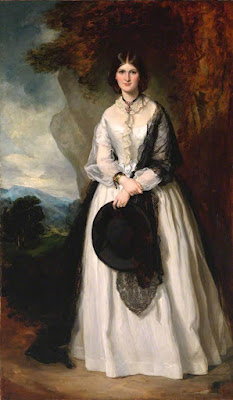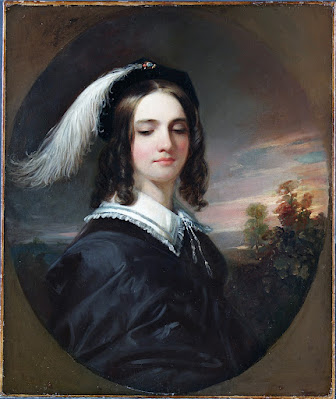 |
| George Hayter Portrait of Queen Victoria 1860 oil on canvas Government Art Collection, London |
 |
| George Peter Alexander Healy Portrait of Sallie Ward 1860 oil on canvas Speed Art Museum, Louisville, Kentucky |
 |
| Emma Gaggiotti Richards Portrait of writer and reformer Adelaide Anne Procter ca. 1855-60 oil on canvas National Portrait Gallery, London |
 |
| Francis Grant Portrait of a Lady ca. 1856 oil on canvas Tate Britain |
 |
| Henry Wyndham Phillips Portrait of designer Owen Jones 1856 oil on canvas Royal Institute of British Architects, London |
 |
| William Powell Frith At the Opera 1855 oil on canvas Harris Museum and Art Gallery, Preston, Lancashire |
 |
| George Richmond Portrait of Thomas Worsley ca. 1850 oil on canvas Downing College, University of Cambridge |
 |
| attributed to William Oliver At the Opera ca. 1850 oil on canvas Manchester Art Gallery |
 |
| Franz Xaver Winterhalter Count Carlo Andrea Pozzo di Borgo 1849 oil on canvas Musée Fesch, Ajaccio, Corsica |
 |
| Christen Købke Portrait of P. Ryder (son of the artist's cousin) 1848 oil on canvas National Gallery, London |
 |
| Jean-Baptiste-Camille Corot The Bride ca. 1845 oil on canvas Musée du Louvre |
 |
| Pieter Christoffel Wonder Portrait of Elizabeth Rosanna Gilbert 1845 oil on canvas private collection |
 |
| William Etty Head of a Cardinal ca. 1844 oil on panel Victoria & Albert Museum, London |
 |
| Daniel Huntington Portrait of Mary Inman 1844 oil on canvas Metropolitan Museum of Art, New York |
 |
| William Bell Scott Portrait of Mrs Halliwell 1840 oil on canvas National Trust, Treasurer's House, York |
 |
| David Wilkie Queen Victoria in Robes of State 1840 oil on canvas Lady Lever Art Gallery, Liverpool |
"Many people believe that Art has breathed its last gasp. I feel that, on the contrary, it is still in its infancy. The Earth is not old; it is barely six thousand years old, a mere instant in the life of a planet. Our Earth is but a child, scarce out of its swaddling bands. To my mind, the masterpieces that are generally believed to be unsurpassable are merely the early efforts of a child who shows promise. Now, at last, comes the time when man must work, and we will soon see what the power of thought, freed from its yoke, is capable of producing. From nature and freedom, combined with imagination, new unexpected marvels will spring forth, and soon a wave of universal belief will buoy up even the heaviest of spirits, like a huge tidal wave righting capsized vessels, propelling us towards new, unknown horizons. . . . What a prodigious instant in the life of humanity we live! Will we not be like gods, as it says in the Bible? Yet this time, there will be no blue venomous serpent to whisper a tempting word into our ear. At last we are finally taking possession of our planet. The forces of nature belong to us, and soon will hold no secrets for Man. A race greater than that of the fabled Titans or the biblical giants will soon cover the globe, and we shall build not Babels of confusion but towers of harmony, matchless pinnacles which will pierce the skies, provoking this time no anger in a jealous God, as we rise above the Flood and the ages of barbarism."
– Théophile Gautier, from Art in 1848, translated by Jonathan Murphy (1998)
"Human skin is as varied in aspect, among us most of all, as is the rest of nature, fields, trees, mountains, water, forests. It happens that one can encounter as much resemblance between a face and a pebble as between two pebbles, since everyone knows it's common enough for faces to appear virtually identical (I'm talking about the question of colour; form is another issue, since there's plenty of formal resemblance to be found between a pebble and a fish, a mountain and the head of a dog, clouds and horses, etc.). So it's only instinct that leads us to say that where coloration is concerned one should seek everywhere for the point of affinity between live forms and those which are dead or vegetating. For instance, it's easy for me to recall the colour of someone's hair because what comes to my mind is that it was hair like polished walnut, or flax, or horse-chestnut. It's the rendering of the form that will then transform this more or less exact tone of walnut, of flax or of horse-chestnut into real tresses with their suppleness and lightness or their stiffness and weight. And then, one paints in such different ways on different supports that the same tone will have one value here and another there. . . . Ah Giotto, don't prevent me from seeing Paris, and you, Paris, let me see Giotto."
– Edgar Degas, from Notebook 22, 1867-74, translated by Charles Harrison (1998)